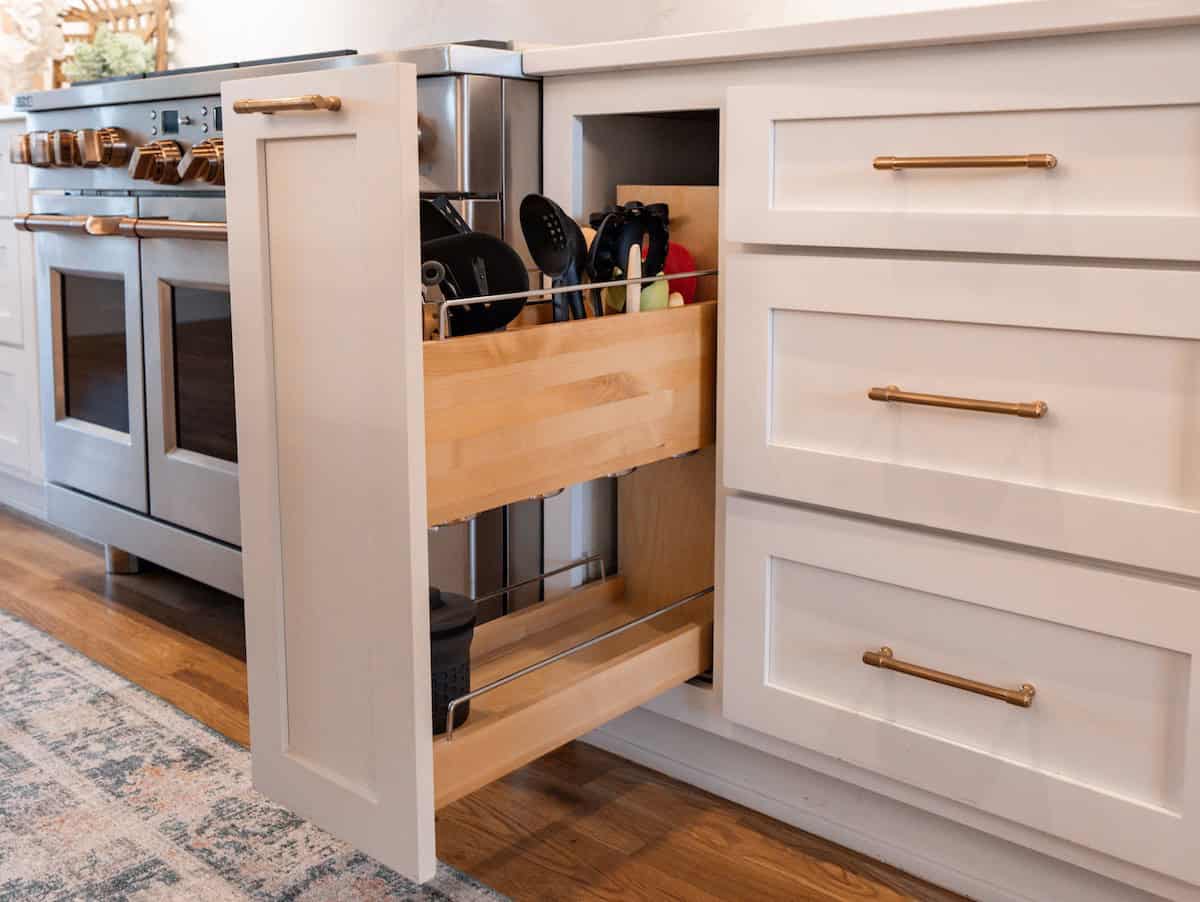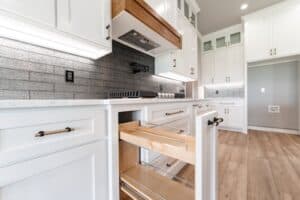
20 Jan Tips to Organize Your Cabinets Like a Pro
Figuring out the right way to organize your cabinets can feel overwhelming. With so many options, sizes, and styles of cabinets, deciding how to make the most of your storage space may seem like a job best left to professionals.
The good news? You don’t need a pro to transform your cabinets into an organized, functional haven. With the right mindset, creativity, and some well-chosen accessories, you can tackle this project on your own and achieve impressive results.
The Problem With Organization for Cabinets
One of the main reasons cabinet organization feels intimidating is the sheer variety of items that are needed in a home. Every category requires thoughtful placement, from pots and pans to spices, cleaning supplies, and snacks.
The key to success, however, lies in understanding your unique needs and embracing solutions tailored to your space. Instead of trying to copy a cookie-cutter approach, focus on creating a system that works for your household.
Another common challenge is maximizing the available space, especially in kitchens with small or awkwardly shaped cabinets. That’s where smart accessories like pull-out drawers, adjustable shelves, and vertical dividers come in.
These tools can help you make the most of every inch, turning even the most cramped cabinets into efficient storage areas. The process may take a bit of planning and trial and error, but it’s entirely doable with the right tools and mindset.
What’s more, organizing your cabinets doesn’t have to be expensive or time-consuming. Many budget-friendly options exist, from DIY drawer dividers to simple hooks and racks.
By combining these affordable solutions with a clear plan, you can achieve a professional-level organization without breaking the bank. Plus, the satisfaction of knowing you’ve done it yourself adds a sense of accomplishment that hiring someone else simply can’t match.
Remember, organizing your cabinets is more than just tidying up; it’s about creating a system that simplifies your daily life. When everything has a designated place, you’ll save time and reduce stress. No more rummaging through cluttered shelves or losing track of what you own. Instead, you’ll have a streamlined, functional space that works for you and your family.
So, take a deep breath and dive in. Start by assessing your needs and envisioning the result you want. With a little patience and the tips outlined in this guide, you’ll be well on your way to organizing your cabinets like a pro – no professional required. Whether it’s tackling a messy under-sink cabinet or finally figuring out how to store all those lids, you’ve got this. Let’s get started!
1. Assess Your Needs and Cabinet Space
Before diving into the organization process, evaluate your cabinets and determine your storage needs. Consider the following:
Inventory: Take stock of your items. Identify frequently used items versus those used occasionally.
Cabinet Size: Measure the dimensions of your cabinets to ensure compatibility with organizers and accessories.
Problem Areas: Pinpoint areas where clutter tends to accumulate, such as under the sink or corner cabinets.
2. Invest in Pull-Out Drawers
Pull-out drawers are a game-changer for maximizing the functionality of your cabinets. They allow you to access items stored in the back without straining or emptying the entire cabinet. Here are some popular options:
Full-Extension Drawers: These drawers extend fully, providing complete visibility and access to stored items.
Soft-Close Mechanism: Opt for soft-close pull-out drawers to prevent slamming and reduce wear and tear.
Multi-Tiered Drawers: Perfect for stacking smaller items like spices or baking supplies.
Pro Tip: Pull-out drawers are ideal for lower cabinets and deep pantry shelves. They’re easy to install and can accommodate various weights and sizes.

3. Utilize Adjustable Cabinet Organizers
Adjustable cabinet organizers allow for customization and adaptability. These are especially useful for changing storage needs over time. Consider these options:
Tiered Shelf Organizers: Ideal for stacking plates, bowls, or canned goods, tiered shelves maximize vertical space.
Expandable Racks: These racks adjust to fit different cabinet widths, making them perfect for storing pots, pans, or lids.
Pull-Out Trash Bins: Keep trash and recycling hidden but accessible with pull-out bins designed for under-sink cabinets.
Pro Tip: Label shelves or bins for easy identification and maintenance.
4. Add Lazy Susans for Corner Cabinets
Corner cabinets are notoriously tricky to organize due to their awkward angles. Lazy Susans offer a practical solution by making use of the entire space. Here’s how to use them effectively:
Two-Tier Lazy Susans: These are perfect for storing condiments, oils, or baking supplies.
Full-Rotation Models: Opt for Lazy Susans that rotate 360 degrees for easy access.
Custom Sizes: Many manufacturers offer customizable options to fit unique cabinet dimensions.
5. Incorporate Drawer Dividers and Inserts
Drawer dividers and inserts keep smaller items neatly separated and easy to find. They’re particularly useful for:
Cutlery and Utensils: Organize forks, knives, and spoons with custom inserts.
Cooking Tools: Use adjustable dividers to separate spatulas, tongs, and whisks.
Junk Drawers: Keep miscellaneous items like batteries, scissors, and tape organized.
Pro Tip: Choose dividers made from durable materials like bamboo or plastic for longevity.

6. Install Vertical Storage Solutions
Vertical storage maximizes space in cabinets with taller dimensions. Here are some ideas:
Tray Dividers: Perfect for baking sheets, cutting boards, and trays, these dividers keep items upright and accessible.
Tension Rods: Use tension rods to create vertical sections for lids or flat items.
Hanging Racks: Install racks on cabinet doors for lightweight items like pot lids or cleaning supplies.
Pro Tip: Ensure vertical organizers are securely installed to prevent tipping.
7. Optimize Under-Sink Storage
The space under the sink is often underutilized due to plumbing fixtures. However, with clever accessories, it can become highly functional:
Sliding Shelves: Install sliding shelves to store cleaning supplies or dishwashing essentials.
Caddy Organizers: Use portable caddies to group similar items for easy access.
Adjustable Shelving: Choose shelves designed to fit around pipes for maximum storage.
Pro Tip: Line the cabinet floor with waterproof mats to protect against leaks.
8. Embrace Clear Containers and Labels
Clear containers and labels make it easy to identify contents at a glance. They’re especially useful for pantry cabinets:
Airtight Containers: Store dry goods like flour, sugar, and pasta in clear, airtight containers to keep them fresh.
Stackable Bins: Use stackable bins for snacks, cereals, or canned goods to save space.
Chalkboard or Printable Labels: Label each container for a clean and cohesive look.
Pro Tip: Group similar items together, such as baking ingredients or snacks, for a more streamlined setup.
9. Upgrade to Soft-Close Hinges and Slides
Soft-close hinges and slides enhance the overall functionality of your cabinets. Benefits include:
Reduced Noise: No more slamming doors or drawers.
Longevity: Soft-close mechanisms minimize wear and tear on cabinets.
Professional Look: They add a touch of luxury to your kitchen.
10. Create Zones for Efficiency
Designate specific zones in your cabinets based on usage patterns. This method ensures that everything has a place and is easy to find. For example:
Cooking Zone: Store pots, pans, and utensils near the stove.
Baking Zone: Keep baking trays, measuring cups, and ingredients together.
Cleaning Zone: Reserve under-sink storage for cleaning supplies.
Pro Tip: Regularly declutter each zone to maintain order.
11. Use Cabinet Door Space
Cabinet doors offer additional storage opportunities. Consider these ideas:
Door-Mounted Racks: Use these for spices, cleaning tools, or lightweight items.
Magnetic Strips: Attach magnetic strips for knives or small metal tools.
Hooks: Install hooks for hanging towels, oven mitts, or utensils.
12. Regular Maintenance
The key to maintaining organized cabinets is regular upkeep. Follow these tips:
Quarterly Decluttering: Review your items every few months and donate or discard what you no longer need.
Cleaning Schedule: Wipe down shelves and organizers to prevent dust and grime buildup.
Reassess Storage Needs: Adjust your cabinet organization accordingly as your lifestyle changes.
You can achieve a functional and visually appealing kitchen by incorporating these cabinet accessories and organizational strategies. With thoughtful planning and the right tools, organizing your cabinets like a pro is within reach. If you are on a mission to organize your cabinets in 2025, reach out to our team! We love providing our customers with unique, custom solutions for their spaces.



Sorry, the comment form is closed at this time.